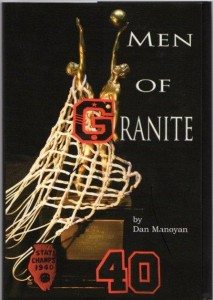DETROIT, Mich.—They were best friends growing up through Sunday School, premiere AYF athletes, community activists, role models and, most of all, proud Armenians from noted family stock.

Nancy Gavoor, right, and Jill Tosoian Dolik continue to remain best friends as Detroit AYF alumnae while remaining atop the all-time Olympic scoring list with 144 points each.
The fact that Nancy Gavoor and Jill Tosoian Dolik competed together for the Detroit “K-T” Chapter was only natural. The fact they both ended their careers tied for the all-time scoring lead with 144 points each was serendipitous.
Neither planned it that way, nor expected it. Fate worked its own miracle in this case. And now, decades later, they still reign as co-champions. Only one other athlete—Ani Almasian Gigarjian—came close to unseating the queen’s throne who mustered 138 points for Providence.
Legendary as they may be, don’t dare call them legends. They’ll admonish such accolades and prefer blending into an Olympic mainstream like one of the gang. That’s their comfort zone.
And it won’t be any different this Labor Day weekend when the games return to Detroit and each plays a humble but gratifying role.
“We’re here to support our committee and community, playing an active role during the weekend,” they proclaim.
To look at Nancy and Jill today, you might be a bit disillusioned. Despite the years, they are still a couple of feisty gals who still chum together, keep the AYF flame burning in their hearts, and their ethnic heritage well groomed and prioritized.
You’ll find Jill pursuing the welfare of her children who have followed a similar athletic path, while an alumni mile wouldn’t be complete without Nancy’s presence. Much of her prowess these days is coaching and conditioning other athletes, many of them the high-scale variety.
It’s a business Jill also pursued after her AYF days. A daughter emerged as a gold medalist in tennis. A son was a tour de force lacrosse player who gained NCAA All-American status. Above all else, Jill has remained a consummate mom.
As for Nancy, her parents (Aram and Violet), along with their siblings (Richard Gavoor, Azad Merian, and the ever-venerable Sue Merian) were active AYFers reaching an iconic level. They all had a significant influence upon her life.
“I grew up in an environment dreaming of competing in the AYF Olympics and becoming a track star,” said Nancy. “Being a natural-born sprinter, I was expected to win all the schoolyard races.”
By the time Nancy reached high school, she became a dominant force as an underclassman. Growing up in St. Sarkis Church, she, Jill, and Diane Panosian were a “talented trio” who could play multiple roles with Rosemary Panosian as their coach.
She made her 1972 debut in auspicious style, winning gold medals in the 50, 100, and 220, breaking 3 records in the process. Olympic regulars knew a star had been born that day.
Nobody was more proud than her parents, Sonny and Itchie as they are called, and Uncle Herman Torigian, her AYF advisor who had delivered her oath.
As for Jill, the 1972 California Olympics was also her inaugural year, joined by her brother John as designated parent and coach.
The Friday morning golf sessions with her dad Cory still continue to bring sentimental memories. After his death, they presented a memorial trophy in his behalf to the alumni winner: a staple of each Olympics.
“We’d have a quiet breakfast together before heading off to the course for warm-ups,” Jill recalled. “His favorite partner was Uncle Nick Stepanian. They were always supporting me in the game.”
Whether it was golf or swimming, Jill continued to remain a formidable competitor while Nancy handled the sprints. Many times, they would each walk away with a high scorer’s trophy, giving their chapter the impetus it needed to succeed.
“My mom [Ann] always made sure I was fed and rested before the swimming that night,” Jill added. “Families like the Panosians and Tians were an integral part of our swim team with their coaching and leadership. Throughout those years in the pool, the Detroit Booster families were ardently cheering us on in the stands.”
With all their hotbed events and all the avid competition and adversity in these games, the irony of finishing tied has been a topic of conversion throughout AYF history. Who would have predicted it, much less expected it?
“The stars aligned,” both women agreed. “Fate played its part. As best friends, it was a perfect ending to a fine career and we were happy it played out that way.”
Jill was quick to admit that Nancy’s growing responsibilities as a Division 1 track coach made it difficult for her to compete in the AYF.
All three of Jill’s children became active in AYF and church from an early age, serving as altar boys and graduating from St. Sarkis Church Sunday School. They each played lacrosse, among other sports, serving as captains of their respective teams and enjoying state championships.
“As proud parents, we enjoyed watching all the games,” said Jill. “Both my sons played Division 1 lacrosse after high school, winning MVP honors and Academic All-American. As parents, we all share in knowing our children are our greatest joy and favorite entertainment. When Nick, our youngest, graduated last year, we went through sport-watching withdrawal.”
While Nancy never got to enjoy her own children, her “kids” were those she coached and mentored. In 2011, she created “Hyenergy Elites,” a premiere high school track and cross country strength-training group. She uses it for a vanity plate as well as an e-mail address.
“At every AYF Olympics, I was able to cheer on my niece Armene in swimming and tennis and my nephew Aram in the pool,” Nancy added. “I would always join my mom at tennis and helped the athletes any way I could with backrubs and special tension-relieving exercises. While my mother is the tennis expert, I sport my latest Nike fashions representing Detroit in style.”
As fitness specialists, Jill and Nancy remained connected to sports while making a career for themselves. Jill is now a registered nurse, minored in nutrition, and created a successful company called “Fitness Factory” with more than 200 teachers nationally.
Among her clients were the Detroit Lions and Detroit Red Wings, two professional teams in football and hockey. Jill still remains active in health and nutrition, guiding private clients toward a healthy lifestyle.
Nancy pursued her degree in physical education and earned a master’s with a concentration in coaching track and field. After coaching at a Division 1 and 3 level, winning the 1989 Outdoor JUCO Track & Field title, she moved back to Detroit to teach physical education for the West Bloomfield Public Schools. She retired this past June to start Hyenergy Fitness LLC working with elite athletes.
It’s safe to assume the two women became passionate about fitness and conditioning by virtue of their own accord as stellar AYF athletes and the people who surrounded them.
“I truly believe I made coaching my career path because of my dad’s involvement with the Detroit AYF,” Nancy confirms. “He gave me coaching responsibilities as early as 1974. I loved it and followed in his footsteps. I was so fortunate to coach cross country at both Schoolcraft College (third nationally in 2000) and Livonia Stevenson High School with my dad from 1997-2007.”
As to the important values they learned from the AYF, it almost goes without saying that character breeds success. Both share the same opinion. Nancy has taken steps toward enhancing her heritage by serving as president of her ARS chapter and joining the board of trustees in her church.
“Our closest lifelong friends are our AYF friends from the East Coast, Mid-Atlantic to Canada, and the West Coast,” they pointed out, listing one name after another like a telephone directory.
“We know all our homes are open to each other and our families can seek comfort and refuge with dear friends,” they added. “The AYF has given us the gift of love and everlasting friendship.”
The post Detroiters Gavoor and Dolik Still Carry Olympic Torch appeared first on Armenian Weekly.


















